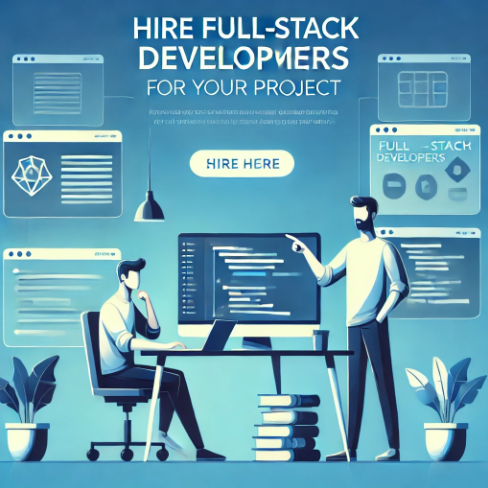
Hiring a full-stack developer can be a game-changer for businesses. They seek expertise in both front-end and back-end technologies. With companies relying more on digital solutions, the need for skilled full-stack developers is rising. They are key to driving growth and innovation. But before you jump into hiring, it’s essential to understand what it means to be a full-stack developer and how they can fit into your project needs.
The Shift Towards Full-Stack Development
In the modern business landscape, every company, regardless of industry, is becoming a tech company. As Satya Nadella, CEO of Microsoft, said, “All companies are software companies. You have to start thinking and operating like a digital company.” Whether you run a manufacturing plant in Ohio or a high-end restaurant in Paris, the need for technical talent has become universal. This has led to a trend. More companies now hire full-stack developers. They can manage both the front-end and back-end of a software application.
However, calling someone a “software developer” is a broad term. Developers can specialize in different areas, such as front-end, back-end, or full-stack development. This guide will focus on full-stack software developers, exploring who they are, why companies need them, and how to find the right candidate.

Who Are Full-Stack Developers?
Full-stack developers are versatile professionals capable of working across all software development layers. But what does “all layers” mean? A full-stack developer can handle all parts of a software app. They can work on the front end (presentation layer), back end (business logic), and database (storage).
- Front-End Layer: This is what users interact with—the visual elements, layout, and design of a website or application. Front-end developers use technologies like HTML, CSS, and JavaScript to create intuitive user interfaces.
- Back-End Layer: This is where the application’s logic resides. It involves handling requests, managing data, and executing business processes. Common back-end languages include Python, Node.js, Ruby, and PHP.
- Database Layer: This layer involves storing and retrieving data from databases like MySQL, MongoDB, or PostgreSQL. It ensures that when users request information, it’s pulled from the right source.
While full-stack developers may not be experts in every layer, they have a good grasp of all three and can work across them seamlessly. A full-stack developer can handle an entire project. They will design the U.I. and manage the server-side logic and databases.
Different Types of Full-Stack Developers Based on Technology Stacks
Just as there are different types of software developers, there are various categories of full-stack developers, each defined by the tech stack they specialize in. Let’s explore some of the most common full-stack stacks:
- MEAN Stack: This stack includes MongoDB, Express.js, Angular.js, and Node.js. All these technologies are JavaScript-based, allowing developers to build both the front-end and back-end using a single language.
- MERN Stack: Similar to the MEAN stack, the MERN stack replaces Angular.js with React.js. React.js is a popular front-end library developed by Facebook that offers a different approach to building user interfaces.
- LAMP Stack: LAMP stands for Linux, Apache, MySQL, and PHP. This stack has been around for a long time and is widely used for traditional web development due to its simplicity and reliability.
- LEMP Stack: Similar to LAMP, but with Nginx instead of Apache, the LEMP stack provides a more efficient way to handle web requests, particularly under heavy loads.
- Full-stack Python is a versatile programming language used for front-end and back-end development. Its developers typically work with frameworks like Django and Flask and databases like MySQL and MongoDB.
- Full-Stack Java: Java-based full-stack development is often used for enterprise applications. Java developers may work with frameworks like Spring Boot for the back-end and various front-end tools.
- Full-Stack Ruby on Rails: Ruby on Rails is a powerful web framework that allows developers to build both front-end and back-end components quickly and efficiently.
You can hire a freelance full-stack developer. Their skills should match your project’s tech requirements. For example, a MERN stack developer would be the right choice if you need a React.js front-end with a Node.js back-end.
Why Do Companies Need Full-Stack Developers?
Given their broad range of skills, full-stack developers are highly sought after. But what makes them so valuable? Here are a few reasons why companies prefer to hire full-stack developers:
- Versatility and Flexibility. Full-stack developers can do both client-side and server-side work. This cuts the need to hire multiple specialists. This flexibility is precious for startups and small businesses that need to maximize resources.
- Streamlined Development Process. Having a single developer (or a small team) manage the entire project can lead to better coordination and fewer communication bottlenecks. Full-stack developers can oversee the whole process, ensuring consistency from front to back.
- Cost-Effectiveness. Full-stack developers may earn higher salaries. But, hiring one is often cheaper than hiring separate front-end and back-end developers. This makes hiring a full-stack developer attractive for companies looking to optimize their budget.
- Faster Time to Market. Full-stack developers can work on multiple layers simultaneously, leading to quicker development cycles. This agility allows companies to launch products faster and respond to changes more efficiently.
- End-to-End Ownership. Full-stack developers can take full ownership of the project. They can handle everything from prototyping to deployment, making them invaluable assets for businesses that need comprehensive solutions.
Key Roles Full-Stack Developers Can Fill
Full-stack developers are versatile and can wear many hats within an organization. Depending on their experience and skill set, they can take on various roles, such as:
- Technical Lead (CTO). Experienced full-stack developers often serve as tech leads, overseeing projects from start to finish. They focus on strategy, team management, and project alignment with business goals.
- Product Manager. Some full-stack developers transition into product management, combining their technical expertise with project management skills to deliver successful products.
- Database Administrator. Full-stack developers with a strong understanding of databases can take on roles as database administrators, managing data storage, retrieval, and optimization.
- Senior Developer. Full-stack developers with extensive coding experience often work as senior developers. They lead teams and mentor junior developers.
Benefits of Hiring a Full-Stack Developer
Hiring a full-stack developer can provide several advantages to your company:
- Complete Technical Expertise. With a full-stack developer, you have a single point of contact for all technical aspects of your project. They can handle both the front end and back end, ensuring a cohesive and well-integrated solution.
- Increased Team Agility. A full-stack developer can work across multiple domains, making your dev team more agile and adaptable to changing project needs.
- Cost Savings. Full-stack developers bring numerous skill sets, reducing the need to hire separate specialists. This can lead to significant cost savings, particularly for small and mid-sized projects.
How Much Does It Cost to Hire a Full-Stack Developer?
The cost to hire a full-stack developer varies depending on their location, experience, and the project’s complexity. Developers in the US, Canada, and the U.K. earn more, while those in Eastern Europe, Asia, and Latin America charge less.
For those considering freelancers, the freelance full-stack developer hourly rate can vary widely. In developed countries, it can range from $75 to $150 per hour. In regions like Eastern Europe and Asia, the rates may be as low as $30 to $60 per hour, depending on the developer’s experience and expertise.
Where to Find Full-Stack Developers
When looking to hire full-stack developers, you have several options:
- Local Hiring. If you prefer face-to-face collaboration and want developers who can work onsite, local hiring is the way to go. Platforms like LinkedIn and regional job boards are great places to start.
- Nearshore Hiring. Nearshore developers are located in nearby countries with similar time zones, making communication easier. For example, U.S. companies often hire developers from Canada or Mexico.
- Offshore Hiring. Offshore hiring means hiring developers from distant regions, like Eastern Europe, Asia, or Latin America. It can save a lot of money, but it needs careful management. There are challenges, like time zone differences and cultural nuances.
If you are open to freelancers, use Upwork. It’s great for finding full-stack developer jobs and connecting with developers worldwide. Additionally, websites like TalentbankAI specialize in vetted offshore development teams and offer a streamlined process for hiring full-stack developers.
Best Platforms for Finding Full-Stack Developers
- Wellfound (formerly AngelList). This platform connects startups with tech talent and is ideal for finding full-stack developers interested in innovative projects.
- Upwork. Upwork is the largest freelance platform where you can discover full-stack developers worldwide for short-term and long-term projects.
- TalentbankAI. Specializes in connecting businesses with vetted offshore development teams. It’s a great platform for finding experienced full-stack developers for long-term collaborations.
Conclusion
Hiring a full-stack developer requires a clear understanding of your project needs and the specific skill sets required. Assess candidates on their experience, skills, and problem-solving abilities. This will help you find a developer who fits your business goals.
For a reliable hiring partner, consider TalentBankAI. It connects you to top full-stack developers from vetted agencies in Eastern Europe and Latin America. By leveraging these resources, you can onboard the right talent quickly and efficiently, ensuring the success of your project.





Leave a Reply